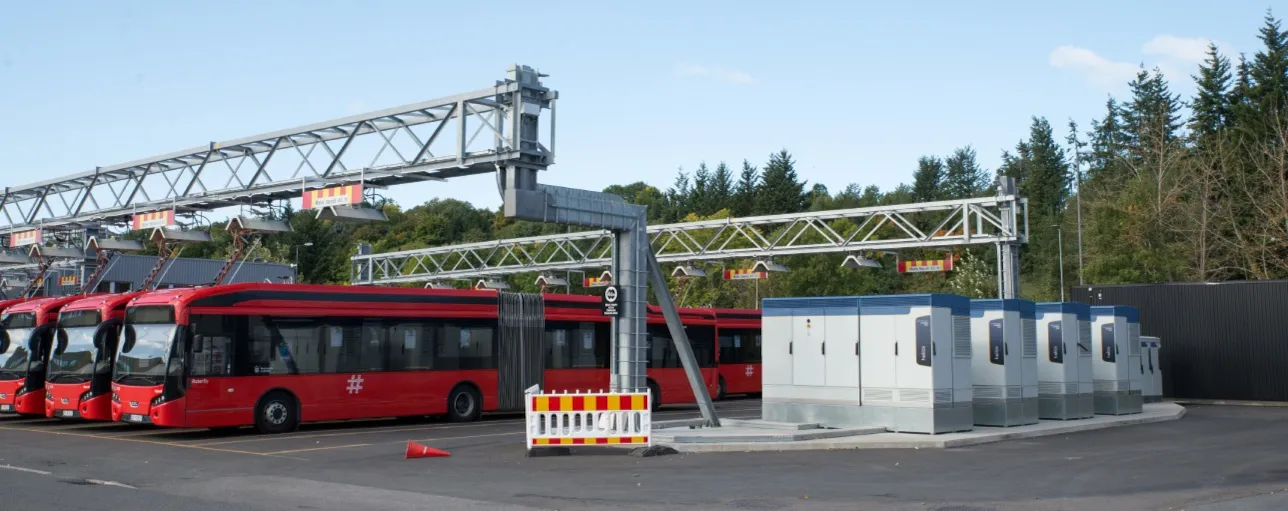The transition from fossil-fuel powered to sustainably powered public transport is not only possible when carefully planned, but also cost-efficient and the preferred solution by the customers, operators and public transport companies. DNV and accilium have, together with clients and partners, successfully demonstrated that sustainable public transport is feasible. Our proposed methodology below explains how.
Our experts have been leading projects in full-electric and hydrogen bus depots in various locations globally, including in Oslo, Norway. The city of Oslo, where more than 500 electric buses and five full electric bus depots will be rolled out in 2020/21, is a frontrunner in zero emission transport. Additional busses and depots will follow, leading to Oslo and its surrounding region being fully serviced by zero emission public transport by 2028. This will be achieved by gradually phasing out diesel and biodiesel for regional buses and transitioning towards hydrogen as a fuel. City buses will mostly adopt battery electric propulsion, with the inclusion of hydrogen range extenders for some high capacity buses. We expect all cities globally to gradually transition to battery and hydrogen electric propulsion, with the benefits of zero particles and zero direct CO2 emission, less noise and improved travel experiences for the public in the future.
On the road to zero emission public transport, it is crucial to understand how different strategies affect investments, operational costs and the resulting total cost of ownership. Planners must address several practical issues early on, such as the additional surface area needed for bus depots, safety considerations for hydrogen filling stations, and necessary long-term planning for grid connections. These issues are often underestimated and are an important part of the planning and roll-out of new solutions. Most importantly, careful planning and a thorough review of charging strategies and operational plans may advance the goal for zero emission transport systems without incurring unnecessary costs.
Realizing the vision of zero emission public transport
Zero emission public transport begins with ambitious goals and visions. Realizing these visions requires market research, stakeholder management, supplier mapping and iterations for optimizing total cost of ownership. Moreover, technical and logistical feasibility assessments as well as targeted research and collaboration with suppliers and other key members of the energy- and transportation industries is necessary. This work culminates in a detailed roll-out strategy. Immature technology requires demonstration, testing and scaling, which may happen in parallel with the activities mentioned above. However, some components for zero emission transport, such as electric buses, are increasingly available at competitive prices.
Our experience is that there are six main factors for optimization of zero emission solutions, which may be optimized for a lowest total cost of ownership:
1. The route design and frequency
may require revision because of technological limitations such as range, number of buses and charge time. Hydrogen range extenders may solve this, but with an additional complexity with filling infrastructure.
2. The bus battery and/or hydrogen capacity
is closely linked to the charging infrastructure and the charging strategy for the vehicle portfolio. The size and capacity of the battery will affect whether slow, fast or ultra-fast charging infrastructure is needed at the bus depot, bus end stations, and en-route bus stops. Depending on the overall fleet size and route characteristics, our experience suggests a few additional (Zero Emission Vehicles) ZEV buses may be needed compared to fossil and biofuel buses due to the need for availability when the regular bus is charging. Costly pantographs and fast charging infrastructure along typical bus routes or at end stations (rather than the bus depot) are being downplayed by the market more and more as battery range increases.
3. Charging infrastructure
is costly, more permanent and fixed with pantographs, transformers and high voltage systems, than for traditional diesel tanks, or new hydrogen tanks in containers. This infrastructure may also require additional (valuable) space. If battery capacity is high enough, the bus may not need to return to the bus depot or wait at a fast charger during the day operations. A smart strategy for less costly fast charging infrastructure, is to ensure “slow” nighttime charging, when fewer buses are in use. The tariffs may also be lower. DNV has experience optimizing important factors of an e-fleet business case, such as the amount of chargers and transformers and inverters needed, charger capacity (kW), grid reinforcement costs or battery banks, which may be needed or profitable.
4. Charging strategy
may both depend on route design, available battery technology and grid infrastructure, or set the standard for which solutions may be chosen according to the transport demand and needs in the region or city. The time used, either actively with drivers and personnel or passively when a bus is unused, impacts the total charging strategy with different possible charge times. Relying on centralized charging (at bus depots) instead of en route charging may lower overall charging infrastructure costs but may increase operational costs due to more driver hours spent. A smart operational plan and charging strategy where both investments and operational costs are evaluated will lead to lower ownership costs and higher profitability.
5. The investment costs for buses and infrastructure with regard to operational costs
depend on the charging strategy, technology solutions available, and operations with the fleet and several other aspects. The lowest total cost of ownership can be optimized on a case-by-case basis based on the local conditions of bus depot sizes and available area, grid capacity, route design and driver hour costs. Other operational costs, which may be affected either positively or negatively depending on the operational strategy, include energy prices and power tariffs. The power tariffs may be a high-risk cost if there is no smart charging due to high tariffs from spikes in the grid capacity take-off.
6. Monetization of grid services from transit bus batteries.
In the next few years, when the zero emission and electric fleets are operational and efficient, DNV and accilium expects the fleets and depots to provide multiple services to the grid when needed. Vehicle to grid (V2G) services is an emerging area where our expertise and planning tools can provide useful insights to make the bus e-fleet an even more cost-efficient alternative.
New technologies enable new opportunities, and various charging and zero emission fuel strategies may affect the total cost of ownership.
Beyond optimization, technologies like autonomous driving open new opportunities and demand an even more holistic view on the six mentioned factors above.
Charging Strategies – optimizing your total cost of ownership
Different charging profiles depending on battery size and charger infrastructure
The article was published by DNV in cooperation with accilium.

